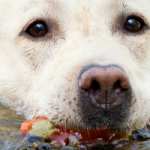by Mary Helen Berg
Congratulations to Mary Helen for being awarded the 2014 Dog Writers Association of America’s AKC Responsible Dog Ownership Public Service Award for this article, which appeared in Just Labs in March/April 2014. We are honored she chose an article she wrote for us for her submission, and thrilled to hear that she was recognized for it by the dog writing community.
One look into your Lab’s deep, liquid brown eyes and you’re a goner. They smile, they seduce, and they are powerful enough to pry a pork chop right out of your palm. Eyes may be the windows to the soul, but they also provide vital information about your Lab’s health. So when the spark in your Lab’s eye fades, it is naturally cause for concern. Labrador retrievers are prone to congenital and acquired eye disorders, and knowing what to look for will help you get your pet the help he needs.
Progressive Retinal Atrophy
If your Lab seems to stumble when it gets dark, his night vision could be failing. Loss of night vision is a symptom of progressive retinal atrophy, or PRA, a group of inherited eye diseases that involve the deterioration of the retina. Labrador retrievers often inherit a breed-specific form of PRA called prcd-PRA, or progressive rod-cone degeneration-PRA, said Dr. András Komáromy, who runs a research lab on canine eye disease at the Michigan State University College of Veterinary Medicine.
This disease attacks the rod cells in the retina, the cells that help the eye see in low light. You may suspect your Lab has this if his eyes have a reflective shine and he seems to have difficulty in dimly lit situations. Unfortunately, prcd is progressive, and your pup may eventually become blind. A veterinary ophthalmologist can diagnose prcd even before symptoms appear with an electroretinogram, a test that measures activity in the retina. Genetic testing can also be conducted with a simple blood sample. There is no treatment or cure or treatment for this disease, but careful breeding has made it less common, Dr. Komáromy said.
Entropion
This condition isn’t pretty and it can be quite uncomfortable for your Lab, but it is relatively easy to correct, said Dr. Robert Peiffer, past president of the American College of Veterinary Ophthalmologists. If your Lab has entropion, it will be obvious in the first year. His eyelid (usually the lower one) will roll in toward his eye. His fur and eyelashes will rub against the surface of the eye causing irritation, excessive tearing, and redness. You may notice that he squints or tries to rub his eye with his paw or on the floor. In more serious cases, the irritation may cause infection, scratch your pup’s cornea, or cause a corneal ulcer.
Entropion can be corrected with plastic surgery that removes a small slit of extra skin below the eye. In some cases, your vet may be able to train the eyelid to stay in the correct position by temporarily suturing the eyelid to the skin below, forcing it to roll out and away from the eye. While entropion is common in Labs, it isn’t directly genetic, said Dr. Peiffer, who has three Labs at home. Instead, it is influenced by a dog’s skull size and rate of growth.
Cataracts
If your Lab has cataracts, one or both eyes will have a milky cast to them. That cloudy appearance around middle age is caused by a change in the lens of his eye. Because cataracts make the lens opaque instead of clear, they prevent light from reaching the retina and eventually cause blindness. Researchers suspect that Labs inherit this common disease, but they have yet to identify the gene that causes it, Dr. Komáromy said. Cataracts can also be caused by diabetes, also common in Labs, or by inflammation or trauma to the eye.
Don’t confuse cataracts with other normal changes that accompany middle age, Dr. Komáromy said. If your dog is around six years old and you notice that his iris has a grayish look, he may have nuclear sclerosis, a hardening of the eye lense that doesn’t impact you dog’s vision unless it grows very dense. This change is a bit like needing reading glasses in your 40s, Dr. Komáromy said.
Cataracts can be removed, but you should think twice before opting for cataract surgery, Dr. Komáromy advised. For some reason, dogs have a much higher rate of complication than humans do after this common eye surgery.
A high percentage of Labradors will develop glaucoma after cataract surgery, even though glaucoma – unrelated to surgery – usually occurs in only 10 percent of Labs. In fact, one-third of all Labradors will develop glaucoma after the surgery, according to a paper published in the Veterinarian Ophthalmology Academic Journal in 2011.
“You can spend all this money and time and your dog could still go blind [following surgery],” Dr. Komáromy warned. “Each owner has to decide whether they want to do it or not. It’s not the end of the world if the dog goes blind. He can still have a life worth living.”
Conjunctivitis and Eye Infections
Ick. You can spot eye infections by the goop that gathers in your Lab’s eye. This common problem is called an “acquired disease,” meaning your dog picks it up, rather than inherits it. Conjunctivitis is the term used for a contagious eye infection usually seen in dogs 18 months or younger and can generally be treated with antibiotic drops. But not all eye infections are contagious, and they can come from a variety of sources.
“The thing about Labs is that they’re so friendly and social and they play a lot at the dog park and doggie day care with other dogs, so they are prone to catching things,” said Dr. Lisa Lomond, who sees 300 dogs a month at her Los Angeles practice. “And they are so outdoorsy, that when they are hiking or playing outdoors they can get foxtail or other foreign bodies under the eyelid.”
If you have a field dog or an active pet who romps a lot in the great outdoors, dust, pollen, and seeds can irritate his eyes and lead to infection. Where you live may help provide a clue to the type of infection and the appropriate treatment, Dr. Peiffer said. For example, in the east, tick-borne Lyme disease can cause a secondary eye infection. In the southwestern U.S., Valley Fever may cause your Labs eyes to become inflamed or cloudy. In the Midwest, your Lab can be blinded and potentially die if he inhales infectious spores from the Blastomyces fungus.
Dr. Komáromy suggested that owners can help protect their adventurous Lab’s eyes by applying a viscous tear gel ointment before each outing and flushing the eyes afterwards with a sterile saline solution.
Retinal Dysplasia
Your Lab can be born with retinal dysplasia and you may not even know it, Dr. Peiffer said. A mild dysplasia, or abnormal development of the retina, may not affect your dog’s vision at all, but a severe case may result in a detached retina and blindness at an early age. In Labs, retinal dysplasia is associated with another syndrome called oculoskeletal dysplasia, he said, which can cause shortened limbs, a detached retina, and early blindness.
As with prcd, a genetic test has been developed to detect the gene for retinal dysplasia. Dogs that have the retinal dysplasia or prcd gene won’t pass the Canine Eye Registration Foundation (CERF) test and should not be allowed to breed, Dr. Komárony said. Selective breeding has helped to reduce the number of dogs born with the disease.
You can promote healthy eyes with antioxidant supplements such as vitamins A, C, and E, recommended Dr. Peiffer. And remember that if your Lab does have a congenital or acquired eye disease that impacts his vision, he can still live a long, healthy life.
However, you may need to adapt your lifestyle together. You’ll need a leash to keep him safe and close on daily hikes; you can no longer allow him to blaze the trail. And you’ll need to be sensitive to where you move the couch. Most dogs who lose their sight learn to negotiate at home just fine, but rearranging the furniture will confuse them. In any case, if you notice any change in your Lab’s baby browns, consult your vet.
“The eyes are sensitive organs, and some of the diseases we see can result in irreversible damage over a period of days,” Dr. Peiffer said. “Eye problems should not be treated lightly. Any of these presenting signs may represent something serious.”
Stay in touch with Mary Helen on Twitter: @maryhelenberg.








